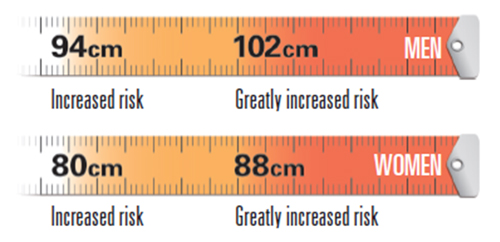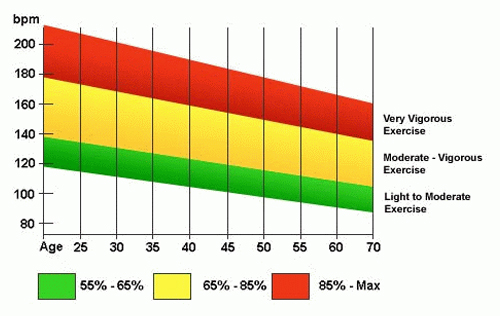Cardiovascular disease still ranks the top cause of death in World. The age of people with coronary heart disease is getting younger, triggered by an unhealthy lifestyle. Therefore, you should always check your heart health regularly, either through a medical checkup series, or check it yourself. You do not need special medical equipment to check your own heart health. Because if you are keen then you can see your own heart conditions using some of these consideration with ease.

-
Waist Circumference
Wider waist circumference does not only cause top muffins or fat that sags around the abdomen. Women whose waist circumference is more than 88 cm have a 79 percent greater risk of dying from any cause (including heart disease and heart cancer), than those whose size is 71 cm or less. To measure it, circle the meter around the waist at the widest part (usually in the area near the navel). “Most stomachs are made by kitchen products,” said Malissa Wood, MD, a cardiologist from Massachusetts General Hospital in Boston.

To begin to streamline it, chew seven to nine servings of fruits and vegetables, and three servings of cereal every day. Every two weeks, also consume fish that are rich in omega-3, such as salmon. Try to consume 30 grams of fiber and at least 50 grams of lean protein every day. Don’t forget cardio exercise for one hour, three days or more in a week. Also train your muscle strength twice a week.
-
Heartbeat at Rest

Heartbeat at rest (via blog.strava.com)
The size of your heart rate zones at rest or not exercising (resting heart rate) can be a good fitness benchmark. The lower, the better your body. If you want to know the condition of your heartbeat, before rising from bed in the morning, use your index and middle fingers to find the pulse on the inner wrist. Calculate the beat for 10 seconds, and multiply the number six times to find the heart rate per minute (bpm, or beats per minute).
Heart rates between 60 – 80 bpm are considered good, in the normal sense. “People who are very healthy have a resting heart rate below 60, and that is good. But a resting heart rate above 60 and below 80 can indicate a problem with dehydration or a basic medical problem, such as thyroid disease or anemia,” Wood said. If your size is not included in both numbers, and you are quite healthy and drink enough water, try consulting a doctor.
Basically, cardio exercise will also help reduce resting heart rate. But the best exercise is interval training. Perform high-intensity exercises in a short time, which will make the heart become more efficient muscles. Add by pedaling a bicycle with a speed interval of 30-60 seconds, or run once or twice a week.

-
Heart Rate after Exercise
You also need to measure the recovery of your heart rate after exercise (heart rate recovery) if you want to check your heart conditions. “The faster the heart returns to its normal pulse after exercise, the healthier your heart will be,” said Cheri Wiggins, MD, a doctor in Twin Falls, Idaho.
If your heart rate doesn’t drop at least 12 beats in one minute after exercise, you run the risk of experiencing heart failure, even death. Calculate your heart rate target with this equation:
(220 – age) x 0.6 = low point of the target heart rate
(220 – age) x 0.8 = the high point of the target heart rate
Example:
if you are 34 years old, then (220 – 34) x 0.6 = 112 for the low point,
and (220 – 34) x 0.8 = 149 for the high point
Then, start exercising, by running or cycling, until you reach that point (use a heart rate monitor to measure it). Then, stop and immediately count the pulse. One minute after you stop practicing, count your pulse again. Subtract the second number from the first number.
If the number is less than 12, your goal is to exercise at least 150 minutes per week, or five sessions per 30 minutes, with aerobic exercise such as brisk walking. No need to be too tired when doing it. On a scale of 1 to 10, do it with an intensity level of 4 or 5. Once your cardiovascular condition gets better and your heart rate after exercise gets higher, increase the duration and intensity of your exercise.
-
Wrinkled Ear Lobe
The lower ear lobe (which is usually pierced for earrings) is slightly folded or wrinkled, often touted as a symptom of coronary heart diseases, high cholesterol, or diabetes. However, you don’t need to believe it right away.
“Heart disease does not cause the ear lobe to contract, or the shrunken lobe causes heart disease. However, the condition seems to be a marker of an unhealthy lifestyle,” said Sarah Samaan, MD, a cardiologist at the Legacy Heart Center in Plano, Texas, and author book Best Practices for a Healthy Heart.
Another study found an 80 percent correlation between folds diagonally shaped in the ears in people under 40 years of age, with coronary artery disease. This fold will not disappear, but you can minimize the risk factors for heart disease itself. For that you need to know a history of heart disease in your family, maintain weight, blood pressure, and cholesterol levels. Besides exercising regularly, eating healthy, and avoiding stress as we are know that heart matters and need to be maintain in the best possible way.

Of course, all of these symptoms and conditions is not fixed on determining your heart conditions. There are several other factors that can contribute to your heart condition. Therefore, it is a good idea to do a regular check up to the nearest heart hospitals in your area. In addition of making your life in ease, knowing that your heart condition are fit. It will allow you to do the best possible treatment to make sure that your heart getting right treatment the first time there are symptoms of any dangerous heart disease that may happen to your body.




